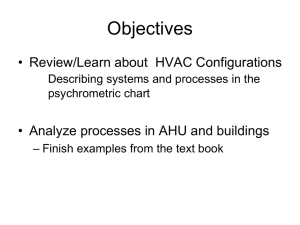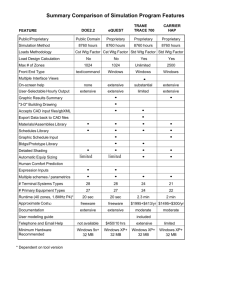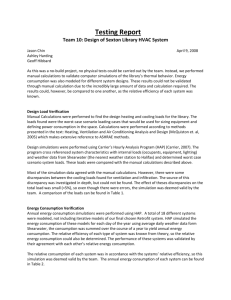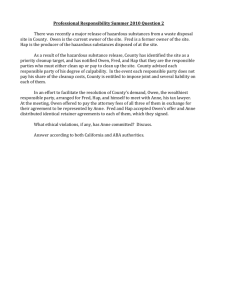Document
advertisement
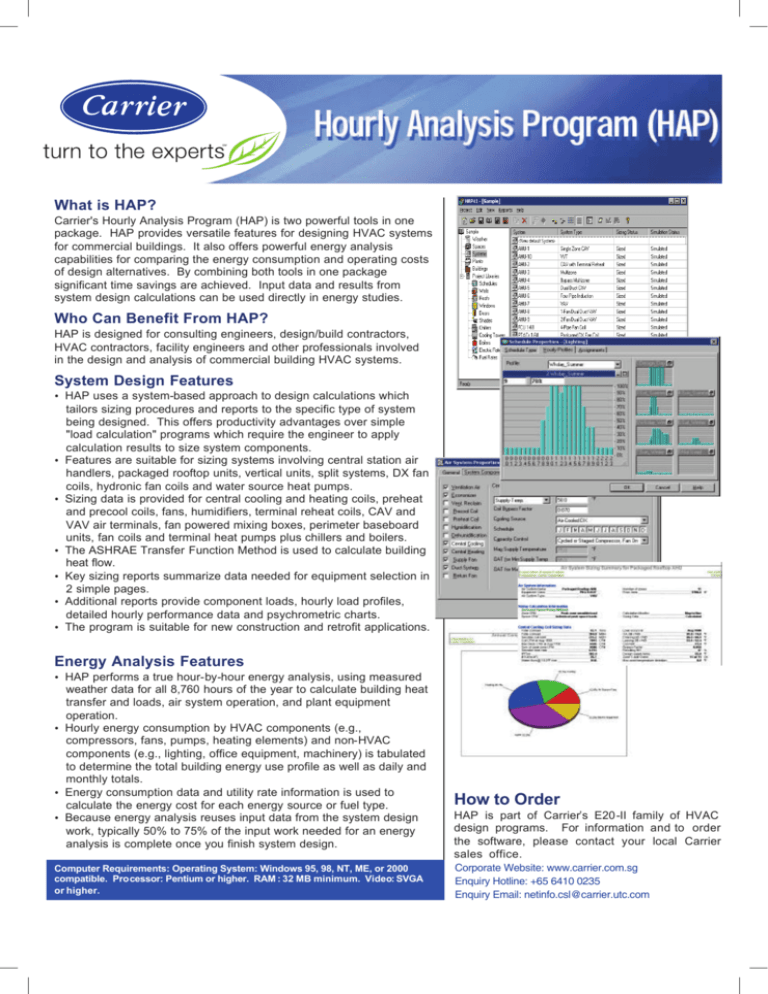
What is HAP? Carrier's Hourly Analysis Program (HAP) is two powerful tools in one package. HAP provides versatile features for designing HVAC systems for commercial buildings. It also offers powerful energy analysis capabilities for comparing the energy consumption and operating costs of design alternatives. By combining both tools in one package significant time savings are achieved. Input data and results from system design calculations can be used directly in energy studies. Who Can Benefit From HAP? HAP is designed for consulting engineers, design/build contractors, HVAC contractors, facility engineers and other professionals involved in the design and analysis of commercial building HVAC systems. System Design Features • HAP uses a system-based approach to design calculations which • • • • • • tailors sizing procedures and reports to the specific type of system being designed. This offers productivity advantages over simple "load calculation" programs which require the engineer to apply calculation results to size system components. Features are suitable for sizing systems involving central station air handlers, packaged rooftop units, vertical units, split systems, DX fan coils, hydronic fan coils and water source heat pumps. Sizing data is provided for central cooling and heating coils, preheat and precool coils, fans, humidifiers, terminal reheat coils, CAV and VAV air terminals, fan powered mixing boxes, perimeter baseboard units, fan coils and terminal heat pumps plus chillers and boilers. The ASHRAE Transfer Function Method is used to calculate building heat flow. Key sizing reports summarize data needed for equipment selection in 2 simple pages. Additional reports provide component loads, hourly load profiles, detailed hourly performance data and psychrometric charts. The program is suitable for new construction and retrofit applications. Energy Analysis Features • HAP performs a true hour-by-hour energy analysis, using measured weather data for all 8,760 hours of the year to calculate building heat transfer and loads, air system operation, and plant equipment operation. • Hourly energy consumption by HVAC components (e.g., compressors, fans, pumps, heating elements) and non-HVAC components (e.g., lighting, office equipment, machinery) is tabulated to determine the total building energy use profile as well as daily and monthly totals. • Energy consumption data and utility rate information is used to calculate the energy cost for each energy source or fuel type. • Because energy analysis reuses input data from the system design work, typically 50% to 75% of the input work needed for an energy analysis is complete once you finish system design. Computer Requirements: Operating System: Windows 95, 98, NT, ME, or 2000 compatible. Processor: Pentium or higher. RAM : 32 MB minimum. Video: SVGA or higher. How to Order HAP is part of Carrier’s E20-II family of HVAC design programs. For information and to order the software, please contact your local Carrier sales office. Corporate Website: www.carrier.com.sg Enquiry Hotline: +65 6410 0235 Enquiry Email: netinfo.csl@carrier.utc.com Climate Analysis Features Plant Equipment Features • Provides a database of design weather data for over • Performs detailed hour-by-hour simulations of plant 700 cities worldwide. • Uses TMY and TRY-type hourly weather data for energy simulations. • Provides a library of simulation weather data for over 400 cities worldwide (included on CD-ROM). Load Calculation Features • Uses ASHRAE procedures for Transfer Function cooling load calculations, design heating load calculations, solar radiation calculations. • Calculates room and zone loads 24 hours a day for design days in all 12 months. • Identifies peak room, zone and coil loads. • Permits hourly and seasonal scheduling of occupancy, internal loads, and fan and thermostat operation. System Design Reports • Provides features for copy-and-paste from displayed reports into other documents, and for saving reports as RTF-format documents. part-load performance. • Plant types include: Chiller plants. District chilled water. Hot water boiler plants. Steam boiler plants. District hot water. District steam. • Models the following chiller types: Water-cooled centrifugal Water-cooled rotary screw. Water-cooled packaged screw Water-cooled packaged reciprocating Water-cooled packaged scroll. Water-cooled single-effect absorption Water-cooled double-effect absorptioin. Water-cooled direct-fired absorption. Water-cooled engine chiller. Air-cooled packaged screw. Air-cooled packaged reciprocating. Air-cooled packaged scroll. • Chiller plants can be configured with the following components and controls: Three types of sequencing controls. Free cooling by strainer cycle or plate-frame HX. Chilled water distribution systems including primary/secondary and variable speed pumps. Air System Analysis Features • Performs detailed hour-by-hour simulations of the • • • • thermal and mechanical behavior of air handling systems for both system design and energy analysis. Equipment types include: Packaged Rooftop Units Packaged Vertical Units Split DX Air Handling Units Chilled Water Air Handling Units Packaged and Split DX Fan Coils Hydronic Fan Coils Water Source Heat Pumps System types include: Single Zone CAV CAV with Terminal Reheat Multizone CAV Bypass Multizone CAV Dual Duct CAV 4-Pipe Induction Tempering Ventilation VAV and VAV with Reheat, Series Fan Powered Mixing Boxes, Parallel Fan Powered Mixing Boxes, or mixed terminals. 1-Fan Dual Duct VAV 2-Fan Dual Duct VAV VVT Systems are configurable with many controls and components including: Supply air temperature reset. Ventilation airflow control. Outdoor air economizers Ventilation air heat reclaim devices. Humidistats and humidifiers. Preheat and precool coils. Perimeter baseboard and fan coil heaters. Permits scheduling of thermostats, fans, cooling and heating on an hourly, daily and monthly basis. Utility Rate Features • Models five common types of electric energy charges. • Models demand charges for both electric and fuel rates. • Permits seasonal and time-of-day energy and demand pricing to be defined. Energy Analysis Reports • Summary reports compare energy use and energy cost of alternate building designs. • Detailed reports provide annual, monthly, daily and hourly performance data. • Extensive use of graphics allows patterns of equipment performance to be quickly understood. • Features provided for copy-and-paste from displayed reports to other documents, and for saving reports as RTF documents. • Exportsure for exporting simulation results to ASCII text disk files makes importing results into spreadsheets simple. Miscellaneous • HAP energy analysis exceeds the minimum requirements for the Energy Cost Budget compliance path for ASHRAE Standard 90.1. 811-XXX
